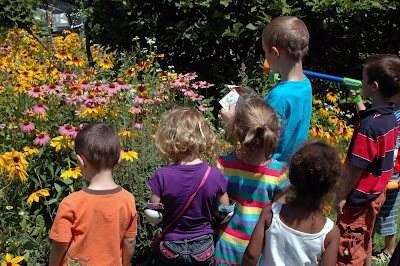It occurred to me that with all the travelling we have done in the past few years, one of the first things I would do was look up bugs/plants that might be poisonous and make sure I knew how to identify them- but here, since I'm in my home country, I don't pay as much attention. I decided my kids needed to be aware of the pests that inhabit the yard and how to deal with them in case of a problem. First up, bees and wasps.
Today, I sat my kids and their cousins down in the front yard to talk about these things they might see in the yard. I told them if they see any of the things on the cards, they should get an adult and point to the picture on the card they saw, so we could properly identify the bug and take care of it the right way.
We walked around the yard to look at some of the most common places a bee or wasp could be spotted:
Here's one eating nectar from a flower:
We used binoculars to look at nests that were up high on the house:
We spotted some down low on the foundation, here is a mudwasp nest:
Yellow jackets like to build their nests inside of things, like the cab of this toy truck. They are very territorial if you disturb them at home- this is why my nephew got attacked, he tried to touch the truck.
Here is the honeycomb we found inside the truck. You can see some of the attackers lying around the ground after being sprayed by my dad:
Most of the kids were outside yesterday when my nephew got attacked. I think they are all scared of bees now. I explained that they can be helpful to us by making honey and killing mosquitoes. I just told them to be aware that they are afraid of us and are just trying to protect themselves and their homes. I warned the kids it is best to stay away from them and let an adult know when they see one, just in case.
My oldest son used the internet to look up some advice for what to do if you are attacked by a swarm of bees or wasps. The best advice he said is to run away as fast as you can and seek shelter. He said you can try to go near flowers to distract them too. NEVER try to swat them away, that will just make them more angry.
For our thrill challenge for the day, all the kids tried a spoonful of honey:
Do your kids know to keep away from bees and wasps and how to identify a hive or nest? If you are bored and looking for a way to have fun in the yard, try to identify some bees and the nests they make in your yard.
If you are looking for more information about bees and wasps, here are a few sites you might like:
Mass Audubon Society- information about bees and wasps common to the state of Massachusetts
Adkins Bee Removal- identification charts for common bees and wasps
Brown County Beekeepers Association- good pictures of common backyard bees and wasps, and nests
Insect Identification- information about common insects you might see in your yard
Honey Bee Research- good advice on what to do if being attacked by bees
Wikihow- how to treat a sting
Getting rid of things- how to get rid of bees nests (with links for hornet, yellow jackets, and other wasps)










A very important and interesting lesson! Thank you for sharing at the Smart Summer Challenge!
ReplyDelete